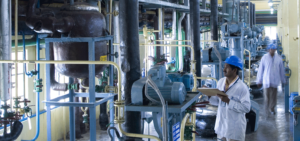 Active Pharmaceutical Ingredients (APIs, or – in layman’s terms – the ingredients that makes drugs work) have grown increasingly complex. Today’s equivalent of boiling tree bark into a tincture typically involves billions of dollars, an eight-to-ten-year path to market and infrastructure that probably looks something like this:
Active Pharmaceutical Ingredients (APIs, or – in layman’s terms – the ingredients that makes drugs work) have grown increasingly complex. Today’s equivalent of boiling tree bark into a tincture typically involves billions of dollars, an eight-to-ten-year path to market and infrastructure that probably looks something like this:
In an older article at BIO’s website discussing the difference between drugs and biologics, a distinction is made between drugs (easy to characterize) and biologics (complex, and difficult to analyze):
“Therefore, for biologics, “the product is the process.” Because the finished product cannot be fully characterized in the laboratory, manufacturers must ensure product consistency, quality, and purity by ensuring that the manufacturing process remains substantially the same over time. By contrast, a drug manufacturer can change the manufacturing process extensively and analyze the finished product to establish that it is the same as before the manufacturing change.” READ MORE.
While accurate, the simple fact is: drugs in general – whether biologic or synthetic – have become more complex… as have the APIs that power them. Today, some APIs require double-digit production steps, meaning understanding and controlling reaction parameters is essential to avoid failures or out-of-spec outcomes. This complexity is driving the increased attention being paid to stringent control over the API’s reaction parameters, both from regulatory and process manufacturing standpoints.
A Holistic Approach to Reaction Control Strategies
Developing strategies to control an API’s reaction parameters should start in early development and stretch right through to manufacturing. Early development work should always be undertaken with the ultimate end-game in mind – an approved drug with the safest, most consistent & reproducible and least-complex manufacturing process possible.
In many cases, analyzing and adjusting reaction parameters or consolidating a process into fewer steps only occurs later in development – sometimes immediately prior to manufacturing. This can be a less-than-ideal circumstance – like trying to quickly develop and install a car engine after someone signs the papers and is ready to drive out of the dealership.
Hectic or rushed work-ups can adversely affect reaction parameters, and lead to increased API variability. At a minimum, they can lead to missed opportunities to reduce manufacturing complexities & costs, and improve efficiencies. In a worst-case scenario, significant regulatory issues can arise.
In cases where we work with clients across a drug’s lifecycle, we minimize this at Neuland with a holistic approach towards process design that begins in early development and continues onward.
What Can Adversely Impact Reaction Parameters?
Over the years, we’ve witnessed a number of examples of missed opportunities for process optimization of various critical reaction parameters. Here are a few of the more common ones we’ve seen:
- Lack of focus on Process Optimization across all stages of development
- Ineffective utilization of raw materials (or improper mole-to-mole conversions)
- Lack of tight control over side reactions and byproduct formation
- Hectic, rushed work-ups and lengthy, multi-step, complex processes
- Improper equipment selection, design or operation
- Insufficient utilities or systems to avoid failures & sudden product shocks during batch execution
How much emphasis does your Company place on process optimization of critical reaction parameters?










